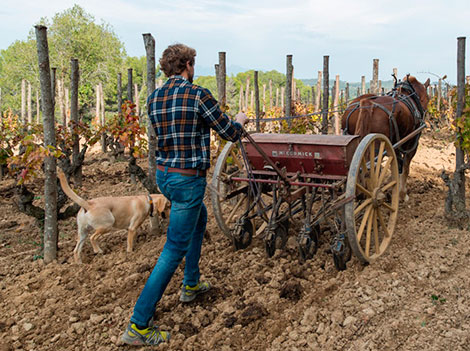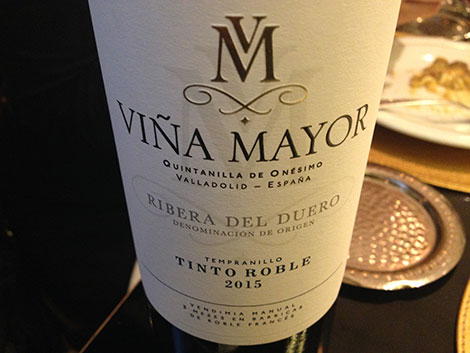
PEPE RAVENTÓS used a very similar photo to the one above on his Christmas cards. Under the motto “Back home, back to our roots”, he presented himself as a happy, biodynamic winegrower ploughing his land with his horse Bru and his puppy, a Labrador appropriately named Bronx given that he and his family spent five years in America. During that period, Pepe not only reinforced the presence of his sparkling wines in the US market; he started seeing things with a wider perspective.
Now the family is happily settled in a new, spacious, dream home built next to the winery where they can share their passion for wine with friends and wine lovers. Many would envy Pepe’s small, private cellar in the basement where he crafts his own natural wines. “I love natural wines,” he admits. “Wine is just wine and it’s really easy to make. Why do we complicate it so much mixing in consumerism, materialism and vanity? We should bare our soul and our wines a little.”
In the late 1980s, his grandfather took the difficult decision to leave Codorníu to set up a new quality-focused project using the family’s hundred-year-old oak tree as its symbol. Pepe and his father followed a similar path when they abandoned the DO Cava in 2012 to create a new appellation governed by more stringent criteria: 100% indigenous grapes, organic or, better yet, biodynamic farming and longer ageing times. Paradoxically, this leap in the dark came from the descendants of Josep Raventós Fatjó, the official inventor of the first Spanish sparkling wine and the father of Cava. Even if the magnificent oak tree withered in 2009 and stopped flowering last spring, nothing seems capable of stopping the family from the new path they have chosen.
Is leaving DO Cava the hardest decision you’ve ever taken?
Cava’s poor image had prompted the thought many times, but it seemed very complicated while we were living in the area. However, the years we spent in the United States gave us the distance to view things differently and we realized that it wasn't actually a problem. We have learnt from the American people to believe in ourselves.
Did anything in particular trigger such decision?
Yes, I was with my wife Susana at Gastón Acurio’s restaurant in Madison Square. We were tasting the wines with the sommelier and when we finished he said: “What are you doing with Cava? This is not Cava; this is something else; you should start from scratch.” So Susana and I looked at each other and realised that what we had been thinking about for so long was not such a crazy idea.
Didn’t you ever consider joining Classic Penedès, the new category for sparkling wines in the DO Penedès?
In my view, Classic Penedès could be compared to Cremant de Bourgogne and other sparkling wine appellations in France which seem to play on a different league to Champagne.
DO Penedès is currently zoning the region. If one of the new subareas is finally called Conca del Riu Anoia you won’t be able to use that name for the new appellation you want to create.
The last thing I heard about that is that they want to call it Costers de l'Anoia. Anyway, if we finally need to use a different name, we’ll just do it. What really matters is the idea behind the project. We may be regarded as the black sheep of Penedès but I am convinced that the region would benefit a great deal from an appellation focused on high-quality sparkling wines with grapes paid at €1 per kilo and sourced from old, organic or biodynamically-farmed vineyards. The big secret is to increase grape prices.
You will need fellow partners for the new appellation. Do you have any?
Not a chance! (he laughs). There are several producers who would meet the requirements but they are too attached to Cava to make the leap. It will take some time, but that’s fine. Right now I feel at ease and relaxed; I think people can notice this.
Do you think the biodynamic requirement can play against finding partners?
Biodynamic farming can be complicated if you do not have an estate of a certain size; it’s not that easy when you grow a few plots scattered over different areas. But the important think is to change your way of thinking and just do it. We started making changes in 2009 and the whole estate became Demeter certified —100 hectares altogether, 60 of which are vineyards— in 2014. One night at Christmas we came back home a little later than usual and found that a fox had eaten our hens. This is also what biodynamics is about.
What are the costs of putting these ideas into practice?
We have uprooted five hectares of Chardonnay and almost two of Pinot Noir, and still have 1.4Ha of Cabernet Sauvignon, set to be grafted shortly, which we sell for little money to other producers. I really find outdated this idea that Cabernet has successfully adapted to Penedès. I think we should champion our indigenous grapes, those which are only found here. I was utterly surprised when I met wine professionals in Brooklyn who had more knowledge about Catalan grapes than my friends from Penedès.
What is the differential character you stand for?
There’s a painting by Catalan artist Joan Miró which has been a turning point for me in the way I understand wine. The Farm represents a traditional Catalan farm and I saw my dream painted there. It made me understand that we have to set our own path, something that we have now accomplished. Vines are more like olive trees than apple trees. How is it possible that we have so little trust in what we have? If you want to be global, you first need to be extremely local. Cava has its place in the world, but in actual fact, it is the champenois method brought here by Josep Raventós Fatjó. Many producers see themselves as cavistas (cava producers) rather than winegrowers. There are over 200 Cava producers but how many of them grow their vines?
Should everything start on the vineyard then?
Winegrowers want to be the best in their individual regions, but this can lead to a vicious circle. We –and I include myself– lack spirituality and generosity. It’s not only about growing vines but about committing to what we do. I have reached this conclusion after a lot of travelling and a great passion for wine. Few New York wine lists feature commercial champagnes. The most exciting wines are not on supermarket shelves. We have to make better wines to improve quality and raise prices and make a living from this.
Raventós i Blanc doesn’t have enough own vineyards to meet its needs.
We are currently buying around 20% from other winegrowers and I want to carry on with this model. I like buying grapes; winegrowers really love their land and appreciate it more than anyone else. I try to buy from the very best and learn from them.
Can sparkling wines from Penedès compete with Champagne?
My dream is to compete on equal terms with Champagne. Winegrowing is best suited to our climate rather than Champagne; we have soils that originated in the sea and neutral grapes which better express the soils. Why should we only consider Champagne when it comes to bubbly? Our history goes back 150 years, and we have the grapes, the soils and the climate. Our work is focused on the following 50 years and with the thought of leaving our children something that is worth living for.
You have always chosen a different path, such as when you blended white and red grapes to make a sparkling rosé, with a majority of white grapes actually.
Rosé Cava used to be rather vinous in the area. Like everyone else, I also planted Pinot Noir and made a rosé wine, but I wasn’t happy with it. I had the chance to discuss this with Nicolas Billecart, from Billecart Salmon, at a wine event in Can Ràfols dels Caus and he told me that in Champagne everyone blends white and red grapes. Thus De Nit was born.
And now you’re working on a separate project for your still wines.
From the 2016 vintage Raventós i Blanc will only make sparkling wines. There will be a separate brand, Vins de Terrer, and independent winemaking facilities for our still wines. In a way, we are closing a door and opening another. We are planning to restore the old mill on the opposite bank of the river and restore a derelict building. It will take us half an hour on foot and five minutes by car to get there. We want all the vineyards in the estate destined for the sparkling wines, so we will need a transition period with the Xarel.lo used for Silencis. We are already looking for new vineyards and all I can say for now is that the new project will combine vineyards of our own with others from purveyors.
Do you have any other dreams?
I have too many, but the most important one has come true and it gives me a lot of peace: to enjoy family life, return to our roots and do things rather than seeking them. I don’t want my children to inherit an industrialized Penedès. I hope that this region, despite its proximity to Barcelona, can make a decent living from winegrowing. Industrial areas ruin the landscape and without landscape there’s no wine. If we do nothing, our region will end up like Baix Llobregat or the Vallés, the towns in Barcelona’s industrial belt.

Amaya Cervera
A wine journalist with almost 30 years' experience, she is the founder of the award-winning Spanish Wine Lover website. In 2023, she won the National Gastronomy Award for Gastronomic Communication
NEWSLETTER
Join our community of Spanish wine lovers






